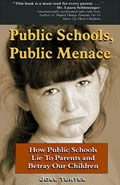PART 4
By
Marilyn MacGruder Barnewall
July 13, 2014
NewsWithViews.com
Part 4: US Debt Obligations Known as CDO's, aka Derivatives
When one invests in derivatives, two entities are betting: The broker and the investor. Sometimes, the broker is betting against the investor to whom he is selling the derivative. If you doubt that, check out stories about Goldman Sachs being fined for doing exactly that.
What can be turned into derivatives? Life insurance, credit card debt – any kind of debt can be turned into a derivative… home mortgages were used in the last go around. Why does debt lend itself so nicely to being made into a derivative? Because people pay interest on debt so there is a ready-made income stream when it is used as an investment product.
The total notional value of derivatives contracts around the world has ballooned to an astounding $770 trillion. No, I’m not exaggerating. Yes, that much money does – or can – exist.
I said there are $770 trillion in “notional” derivatives contracts around the world. What does “notional” mean? Notional does not represent the actual amount of dollars invested in a derivative product; thus, the $770 trillion in notional derivatives is not the actual amount of dollars invested in derivatives contracts. It does mean that there are $770 trillion of derivatives for sale… that $770 trillion has been created if you’re stupid enough to invest in derivatives. IT DOES NOT MEAN $770 TRILLION HAS BEEN INVESTED IN THESE DERIVATIVES.
Other estimates of the notional value of derivatives puts the grand total well over a quadrillion dollars. If that sounds like a lot of money, it is; so much, it’s almost unfathomable. For example, U.S. GDP is projected to be in the neighborhood of around $17 trillion for 2014. So how many years would it take the U.S. to cover the derivatives debt of $770 trillion if 100 percent of our budget went to pay off these debts? We would make no welfare payments, no Social Security payments, no money goes to the military – we would use the total budget to pay for derivative losses. It would take about 45 years if America’s total GDP was used to pay this debt.
According to official government numbers, the top 25 banks in the United States now have a grand total of more than $236 trillion of exposure to derivatives. But there are four banks that dwarf all of the others. The following are the latest numbers for those four banks...
JPMorgan
Chase
Total Assets: $1.9 trillion
Total Exposure To Derivatives: $70,088,625,000,000 (more than 70 trillion
dollars)
Citibank
Total Assets: $1.3 trillion
Total Exposure To Derivatives: $62,247,698,000,000 (more than 62 trillion
dollars)
Bank
Of America
Total Assets: $1.4 trillion
Total Exposure To Derivatives: $38,850,900,000,000 (more than 38 trillion
dollars)
Goldman
Sachs
Total Assets: $106 billion
Total Exposure To Derivatives: $48,611,684,000,000 (more than 48 trillion
dollars)
Let’s look at mortgage-backed derivatives – the derivatives product that caused the shock and awe of the financial services community and led to the near bankruptcy of our nation in 2007.
You want to buy a house and you apply for a mortgage with your local bank. You close on the property and move in and everything is fine (you think) until someone in the household loses his or her job. You fall behind on your house payments and one day you receive a Notice that the bank is going to foreclose on your home. Did you know that there are tent cities outside of most population centers that have people living in them who have just gone through this experience?
Let’s go back and look at the process of your mortgage loan closing and what many people do not understand. If you have read your mortgage loan papers, you are aware that you signed a mortgage loan that gave your bank permission to sell your loan to another financial institution. They probably didn’t tell you that the “other financial institution” was going to be named Goldman Sachs or Freddie Mac or Fannie Mae. If they’d have told you that, you might have become suspicious that your home mortgage was going to be placed in a package of mortgages that to create a mortgage-backed derivative.
What is a mortgage-backed derivative? A stock broker or an investment bank takes a number of mortgages – let’s say they use 100 mortgage loans just like yours – and they package it and sell it to investors. Why do investors want such an investment? Because people are paying 6 percent to 10 percent in loan interest on their mortgage loans – and as everyone who has ever paid interest on a mortgage loan knows, almost the total house payment is loan interest during the early years of a loan.
Let’s say your home payment is $900 a month. Interest during the first ten years of the mortgage payment may be as high as $750 or $800 (depending on whether your payment includes principal, interest, taxes and insurance. Let’s say there are 100 mortgages which average $800 per month in loan payments… some payments are higher, some are lower, but they average $800 monthly. Every month, that package of mortgage loans provides $80,000 in loan interest to investors. Though the investment return goes down slightly each month as the up-front interest is paid and the equity amount increases, as any homeowner knows, that happens very slowly and income from this investment was supposed to pay investors for the 30-year term of the mortgages contained in the derivative.
But let’s go back to the process your bank used that got your home mortgage included in a derivative with 100 people who are total strangers to you. The bank sold your loan to a stock broker, immediately getting the bank’s money back from this sale – plus they got all of those fees you paid at loan closing. That’s a pretty sweet deal for the lending bank. They have no loan loss risk and they’ve made a profit. The stock broker who purchased your loan now owns it and puts it into the derivative package – so now investors own the loan. Or, do they?
Low interest mortgages were designed to get people to buy homes so the bank could sell the loan and the stock broker could create a mortgage-backed derivative package to sell his or her clients. It lit a fire under property values. People began investing in real estate because it was worth $100,000 one day and $200,000 the next day. That – along with one other thing – caused the system to collapse.
Brokers, especially in London, began re-selling the same mortgage-backed derivatives package to other investors. In some cases, the same package was sold 40 times. That caused economic chaos and the result was that a lot of people lost their jobs as companies went out of business and that resulted in a lot of bad mortgage loans that were now going into default. Those mortgage-backed derivatives packages that used to pay investors $800 a month – or $9,600 annually) suddenly couldn’t pay the investors and the entire pyramid scheme collapsed on itself.
Millions of Americans were foreclosed on by – guess who? The bank that made the original loan and sold it to the stock broker and got its money back when the mortgage was first sold. The broker who put the loan into a package of mortgage-backed derivatives sold it to investors and got its money back, too. Good people were evicted from their homes like yesterday’s trash. When they went to court, the bank walked in with its note, signed by the person who is facing foreclosure, and demanded that the court evict the people who had lost their jobs and stopped making house payments and also demanded the house be given back to the bank – yes, the same bank that sold the mortgage and had no money invested in the property being foreclosed.
When they went to court, the bank walked in with is note, signed by the person facing foreclosure, and demanded the court find in favor of the bank that made the loan. The bank loan (or note) does say that the borrower is pledging as collateral for the loan the house that is being foreclosed for non-payment.
What most people didn’t – and still do not – realize is that the loan and the Deed of Trust (or the title) are two different documents. People felt helpless to fight foreclosure because they didn’t realize that to foreclose, the foreclosing party must provide the court with a Deed of Trust or Title to the property to prove ownership!
Most of the banks doing the foreclosing didn’t have the Deed of Trust. Most of them didn’t have the Title. Why? Because it went to the party purchasing the loan from the bank: The broker. The broker doesn’t have the Deed of Trust or Title, either, because the investors now own the properties… but the investors aren’t the ones doing most of the foreclosures. Banks and brokers are/were doing the foreclosing – neither of which has proof of ownership. And the courts let them get away with it!
You would think the courts would know the difference – they would know that to lawfully foreclose on a residence, the Deed of Trust/Title proving ownership must be provided to the court. Was there collusion in the courts? In many cases, yes. In many cases it was sheer ignorance of the law by the judge making the foreclosure decision. Judges all over the country accepted as grounds for foreclosure the bank’s mortgage loan papers. Those judges were wrong. Loan papers do not prove home ownership by the bank. Regardless, the homeowner was evicted from the residence – all because they didn’t understand the law or their rights under it.
Having a borrower’s signature on a loan document that says “I’m pledging my home as collateral for this loan” proves borrower intent to give up the home if the loan cannot be paid. It does not, however, prove the bank has legal Title – ownership – to the property. Only a Deed of Trust – a Title to the property – does that.
This example of mortgage-backed derivatives doesn’t come close to covering the different kinds of derivatives packages that are put together for bond-backed and other forms of derivatives that are still actively being sold in the marketplace by these same high-risk investment banks which have merged with our commercial banks. It is that last statement that makes the current structure of the financial services marketplace so dangerous. It is what makes some banks too big to fail. It isn’t the failure of the investment banks (which are at the core of the derivatives problem) that could take down our great nation. It is the threatened take-down of the commercial banks (which are little-involved in the derivatives problem that caused the financial breakdown of 2007/08). How can that be? The Gramm–Leach–Bliley Act (GLB), also known as the Financial Services Modernization Act of 1999.
The United States Congress did away with the Glass Steagall Act and replaced it with Gramm, Leach, Blyley (also known as the Financial Services Modernization Act of 1999). When that happened, consumers lost the protections under Glass Steagall. Good Republican Phil Gramm of Texas (who, along with his wife, is an economist) made it possible for investment banks to become part of commercial banks. Glass Steagall prevented such a joining, and wisely so.
|
Investment banks can get very, very sick and the nation’s economy may get a bad case of the flu. If commercial banks get very, very sick, the nation’s economy may die. The two kinds of banking should have been kept separate – should once again be made separate.
As for derivatives, they are in my opinion unlawful because there is much evidence that securitization is unlawful and securitization is part of the derivatives process. That, however, is just an opinion. Here’s another opinion: Derivatives are worthless pieces of paper with no value attached to them.
Keep that in mind the next time you hear that all of the debt being taken on by the U.S. Treasury via the Federal Reserve System is collateralized by derivatives. In other words, all of that debt is collateralized by junk paper.
Click here for part -----> 1, 2, 3, 4,
� 2014 Marilyn M. Barnewall - All Rights Reserved
Sign Up For Free E-Mail Alerts
Marilyn MacGruder Barnewall began her career in 1956 as a journalist with the Wyoming Eagle in Cheyenne. During her 20 years (plus) as a banker and bank consultant, she wrote extensively for The American Banker, Bank Marketing Magazine, Trust Marketing Magazine, was U.S. Consulting Editor for Private Banker International (London/Dublin), and other major banking industry publications. She has written seven non-fiction books about banking and taught private banking at Colorado University for the American Bankers Association. She has authored seven banking books, one dog book, and two works of fiction (about banking, of course). She has served on numerous Boards in her community.
Barnewall is the former editor of The National Peace Officer Magazine and as a journalist has written guest editorials for the Denver Post, Rocky Mountain News and Newsweek, among others. On the Internet, she has written for News With Views, World Net Daily, Canada Free Press, Christian Business Daily, Business Reform, and others. She has been quoted in Time, Forbes, Wall Street Journal and other national and international publications. She can be found in Who's Who in America, Who's Who of American Women, Who's Who in Finance and Business, and Who's Who in the World.
Web site: http://marilynwrites.blogspot.com
E-Mail: marilynmacg@juno.com













 Share
This Article
Share
This Article




